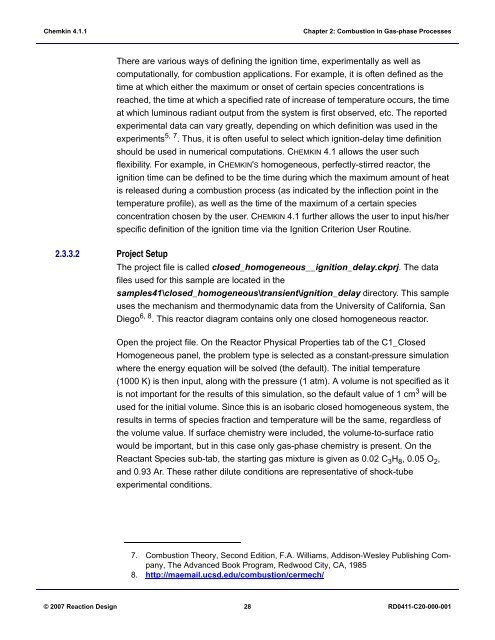Tutorials Manual
Tutorials Manual
Tutorials Manual
You also want an ePaper? Increase the reach of your titles
YUMPU automatically turns print PDFs into web optimized ePapers that Google loves.
Chemkin 4.1.1<br />
Chapter 2: Combustion in Gas-phase Processes<br />
There are various ways of defining the ignition time, experimentally as well as<br />
computationally, for combustion applications. For example, it is often defined as the<br />
time at which either the maximum or onset of certain species concentrations is<br />
reached, the time at which a specified rate of increase of temperature occurs, the time<br />
at which luminous radiant output from the system is first observed, etc. The reported<br />
experimental data can vary greatly, depending on which definition was used in the<br />
experiments 5, 7 . Thus, it is often useful to select which ignition-delay time definition<br />
should be used in numerical computations. CHEMKIN 4.1 allows the user such<br />
flexibility. For example, in CHEMKIN'S homogeneous, perfectly-stirred reactor, the<br />
ignition time can be defined to be the time during which the maximum amount of heat<br />
is released during a combustion process (as indicated by the inflection point in the<br />
temperature profile), as well as the time of the maximum of a certain species<br />
concentration chosen by the user. CHEMKIN 4.1 further allows the user to input his/her<br />
specific definition of the ignition time via the Ignition Criterion User Routine.<br />
2.3.3.2 Project Setup<br />
The project file is called closed_homogeneous__ignition_delay.ckprj. The data<br />
files used for this sample are located in the<br />
samples41\closed_homogeneous\transient\ignition_delay directory. This sample<br />
uses the mechanism and thermodynamic data from the University of California, San<br />
Diego 6, 8 . This reactor diagram contains only one closed homogeneous reactor.<br />
Open the project file. On the Reactor Physical Properties tab of the C1_Closed<br />
Homogeneous panel, the problem type is selected as a constant-pressure simulation<br />
where the energy equation will be solved (the default). The initial temperature<br />
(1000 K) is then input, along with the pressure (1 atm). A volume is not specified as it<br />
is not important for the results of this simulation, so the default value of 1 cm 3 will be<br />
used for the initial volume. Since this is an isobaric closed homogeneous system, the<br />
results in terms of species fraction and temperature will be the same, regardless of<br />
the volume value. If surface chemistry were included, the volume-to-surface ratio<br />
would be important, but in this case only gas-phase chemistry is present. On the<br />
Reactant Species sub-tab, the starting gas mixture is given as 0.02 C 3 H 8 , 0.05 O 2 ,<br />
and 0.93 Ar. These rather dilute conditions are representative of shock-tube<br />
experimental conditions.<br />
7. Combustion Theory, Second Edition, F.A. Williams, Addison-Wesley Publishing Company,<br />
The Advanced Book Program, Redwood City, CA, 1985<br />
8. http://maemail.ucsd.edu/combustion/cermech/<br />
© 2007 Reaction Design 28 RD0411-C20-000-001
















